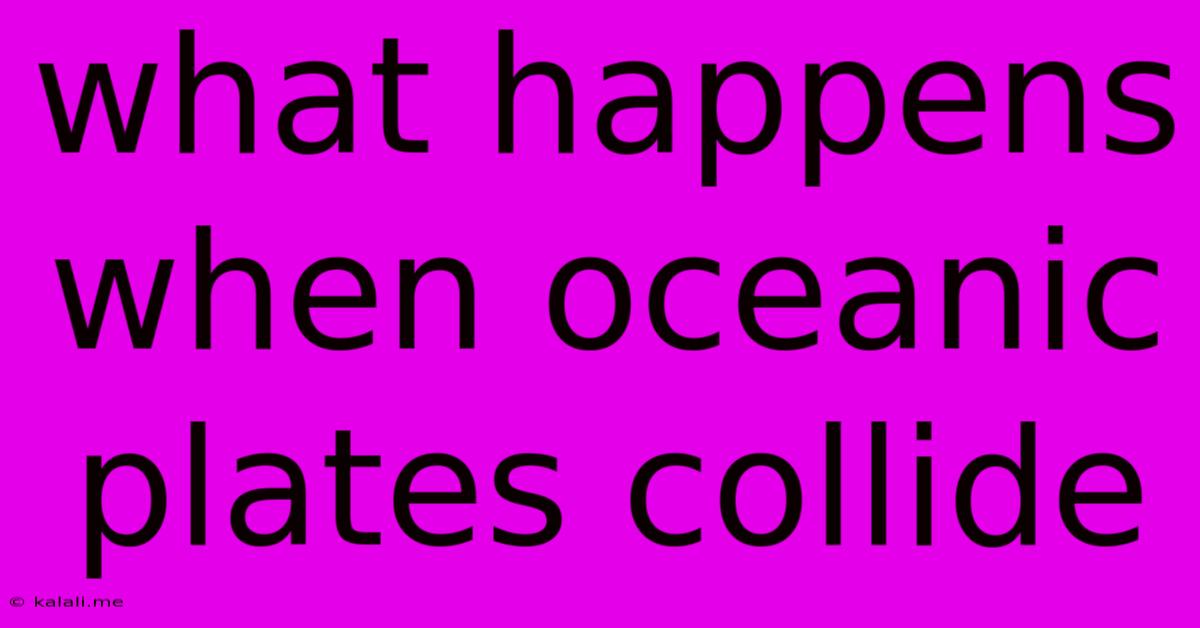What Happens When Oceanic Plates Collide
Kalali
May 09, 2025 · 3 min read

Table of Contents
What Happens When Oceanic Plates Collide? A Deep Dive into Subduction
When two oceanic plates collide, a dramatic geological event unfolds, shaping our planet's surface and influencing its internal dynamics. Unlike the collision of continental plates which leads to the formation of mountain ranges, the meeting of two oceanic plates results in a process called subduction. This article will explore the intricacies of this process, detailing the resulting features and their significance.
Understanding Plate Tectonics: Earth's lithosphere, the rigid outer layer, is broken into several large and small plates that are constantly moving. These plates interact at their boundaries, leading to diverse geological phenomena, including earthquakes, volcanoes, and mountain building. The density of the plates plays a crucial role in determining the type of interaction.
The Subduction Process: When two oceanic plates converge, the denser of the two will bend and slide beneath the less dense plate, a process known as subduction. This denser plate sinks into the Earth's mantle, a process that can take millions of years. The angle of subduction varies depending on factors such as the age and density of the plates, and the rate of convergence.
Formation of Trenches: The Deepest Parts of the Ocean
The subduction zone is marked by a deep-sea trench, the deepest part of the ocean. These trenches can reach depths exceeding 10,000 meters (33,000 feet), far exceeding the average ocean depth. The Mariana Trench, the deepest known point on Earth, is a prime example of a trench formed by oceanic-oceanic plate convergence. The immense pressure and temperature gradients at these depths contribute to unique ecosystems and geological processes.
Volcanic Island Arcs: A Ring of Fire
As the subducting plate descends into the mantle, it experiences increasing pressure and temperature. Water trapped within the plate is released, lowering the melting point of the surrounding mantle rock. This melted rock, or magma, is less dense than the surrounding mantle and rises to the surface, leading to volcanic activity. This volcanic activity often manifests as a chain of volcanoes known as a volcanic island arc. These arcs are typically curved, reflecting the shape of the subduction zone. Examples include the Japanese archipelago, the Aleutian Islands, and the Indonesian archipelago. These areas are often seismically active, experiencing frequent earthquakes.
Earthquakes: A Tremorous Consequence
The subduction process is not smooth. The movement of the plates generates immense friction, leading to the buildup of stress along the plate boundary. This stress is periodically released in the form of earthquakes, ranging in magnitude from minor tremors to devastating mega-quakes. These earthquakes can be shallow, occurring near the trench, or deep, occurring within the subducting plate itself. The location and depth of these earthquakes provide valuable information about the subduction process and the structure of the Earth's interior.
Accretionary Wedges: Building Up the Seafloor
Not all of the subducting plate is completely consumed. Some sediments and oceanic crust can be scraped off and added to the edge of the overriding plate. This accumulation of material forms an accretionary wedge, a complex structure of folded and faulted rocks. These wedges can contribute to the growth of continental margins over geological time.
The Role of Plate Age and Density
The age of the oceanic plates plays a vital role in the subduction process. Older oceanic plates are colder and denser than younger plates. Consequently, older plates are more likely to subduct beneath younger plates. Density differences are the primary driving force behind subduction, governing which plate will be forced beneath the other.
In conclusion, the collision of oceanic plates results in a dynamic and complex interplay of geological forces, creating significant features like deep-sea trenches, volcanic island arcs, and accretionary wedges. Understanding these processes is crucial for comprehending Earth's tectonic evolution, predicting seismic activity, and managing geological hazards in these regions. The study of oceanic-oceanic plate collisions continues to yield valuable insights into the internal workings of our planet.
Latest Posts
Related Post
Thank you for visiting our website which covers about What Happens When Oceanic Plates Collide . We hope the information provided has been useful to you. Feel free to contact us if you have any questions or need further assistance. See you next time and don't miss to bookmark.